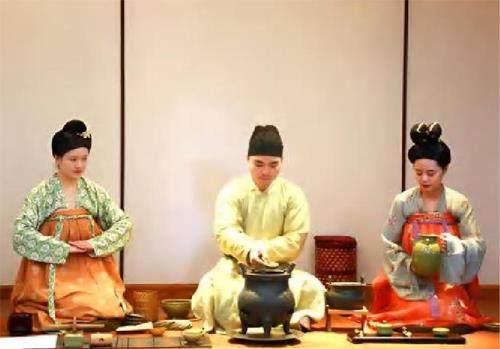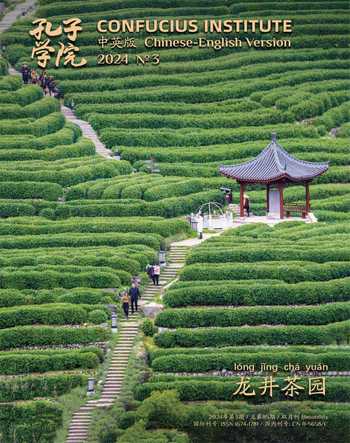中国茶的饮用流变Evolutions in Chinese Tea Drinking Culture
朱阳


茶是中国人的国饮,不仅丰富着人们的日常生活,还深刻影响着文化与社交。无论是大俗还是大雅,茶对于中国人来说都是不可或缺的。茶在中国有着悠久的历史、丰富的内涵,其饮用方式也随着时代更替发生着变化。
Tea stands as the quintessential beverage in the Chinese cultural landscape, elevatingnot just the daily routine but also leaving an indelible mark on the nations culture andsocial dynamics. Whether savored in refined settings or embraced by the masses, tea holdsan irreplaceable role in the lives of the Chinese populace. Its extensive history and nuancedsignificance have woven a tapestry of meaning in China, with consumption practicesevolving in tandem with the passage of time.
中国茶文化兴起于唐代。当时,饮茶的习俗已经逐渐从寺庙僧侣向贵族阶层延伸,也不再类似以前的“生煎羹饮”,而逐渐盛行“煮茶法”。“茶圣”陆羽在《茶经》中提倡清茶烹煮的饮茶方式:在煮茶前先烤茶,使茶饼变软;后用纸包好,以保其香;冷却后,碾成细末,再过筛贮于茶盒中。在煮茶时要掌握好火候,协调好茶、水、盐三者用量的比例关系,这便是唐代煮茶的精髓。
Chinas tea culture blossomedduri ng the Tang Dynas ty.During this period, the practiceof consuming tea transcendedits origins among Buddhistmonks, gradually permeatingthe aristocratic class. Unlike theearlier rudimentary “boilingraw tea leaves as soup to drink,”a refined approach emerged,known as the “boi l i ng teamethod,” gaining popularity. Inhis seminal work, The Classic ofTea, the revered “Tea Sage” Lu Yuardently advocated this method.Lu Yus prescribed processinvolved initially roasting teacakes to a softened state, followedby grinding and wrappingthem in paper to preserve theiraromatic essence. After cooling, the tea was stored in a dedicated tea caddy. The brewing process wasan art, requiring mastery of heat control and a delicate balance between tea, water, and salt — thequintessence of Tang Dynasty boiled tea.
唐代煮茶法尤为讲究,所需茶具种类繁多,其中有风炉、茶臼、茶碾、茶瓶、茶盒等。特别值得一提的是陕西法门寺地宫中出土的皇家宫廷茶具,其质地以金银为主,异常精美,是目前所知中国最早、最完备的宫廷系列茶具实物,当时的饮茶方式由此可见一斑。
The intricacies of the Tang Dynasty boiled tea method demanded a range of specialized teautensils, including wind stoves, tea mortars, tea grinders, and tea caddies. Of particular significanceare the imperial court tea sets unearthed from the subterranean chambers of Famen Temple inShaanxi. Crafted meticulously from gold and silver, these artifacts represent the earliest and mostcomprehensive collection of imperial court tea utensils in China, offering a fascinating glimpse intothe tea-drinking customs of that era.
宋代斗茶
Tea Competition in the Song Dynasty
中国茶文化兴于唐而盛于宋,宋时茶风炽盛,相较于唐代,饮茶方式有了较大的发展和变化,“煮茶法”逐渐演变为“点茶法”。点茶法的盛行又促生了斗茶的习俗,人们通过炙茶、碾茶、罗茶、候汤、熁(xié)盏、点茶等多道程序鉴评茶叶品质,比试点茶技艺的高下。
While the Tang Dynasty marked the inception of Chinese tea culture, it reached its zenith during the SongDynasty. In contrast to the Tang era, the practice of tea consumption underwent substantial transformations,transitioning from the traditional “boiling method” to the innovative “tea art method” (dian cha). Theemergence of dian cha brought about the tradition of tea competition (dou cha). This ritual comprised ameticulous evaluation of tea leaves, with participants showcasing their prowess in the art of dian cha. Theprocess encompassed various steps, including roasting the tea (zhi cha), grinding the tea (nian cha), sifting thetea (luo cha), heating the water (hou tang), warming cups (xie zhan), and ultimately, the precision of dian cha.
炙茶:即烘焙茶叶。如果点茶用的团饼是陈茶(色香味皆陈),则须先用微火炙干,新茶一般不炙。
Zhi cha: It means baking the tea leaves. If using aged compressed tea cakes (which may havediminished color, aroma, and flavor), a light roasting is necessary to revive them. Fresh teagenerally does not require roasting.
碾茶:先用干净的纸包裹茶叶,捶碎,然后碾细。
Nian cha: Begin by wrapping the tea leaves in a clean paper packet and crushingthem, then proceed to grind them into a fine powder.
罗茶:即筛茶。碾好的茶末需要过筛,筛得越细越好。
Luo cha: This step involves sifting the ground tea powder through a mesh. The finer thepowder is sifted, the better.
候汤:即煮水。讲究三沸,要求当水烧过二沸、刚到三沸之际,就迅速停火,冲注。
Hou tang: Also referred to as waiting for the boil, this step emphasizes the three boiling stages.Once the water is approaching the third boil after passing the second, swiftly extinguish the fireand pour the water.
熁盏:又称为“温盏”。凡是点茶,必须先熁盏使之热。如果盏冷,茶便浮不起来。
Xie zhan: Also known as wen zhan, this step is essential for making tea art. A cold cup can hinder theproper frothing of the tea.
点茶:先投茶,后注汤调匀,谓之“调膏”。接着开始点茶:“七汤”为最佳,每汤之间注入沸水,用茶筅(xiǎn)击拂,其力度与幅度都应有所不同,直至茶汤稀稠适中,即可停止拂动。 最后,茶汤表面会形成乳白色的汤花,犹如绵密的泡沫:投入的茶少而加入的水多,茶味就比较清淡,称为“云脚散”;投入的茶多而加入的水少,茶味则比较丰富,称为“粥面聚”。
Dian cha: Begin by adding the tea powder, followed by hot water, and stir evenly. The process isknown as “adjusting the cream.” Then, commence pointing the tea through seven infusions, whichis considered ideal. Between each infusion, add boiling water, adjusting the force and duration ofthe whisking motion with the tea brush. Continue until the tea reaches the desired concentration,then cease whisking. A milky white pattern will eventually form on the surface of the tea soup,resembling dense froth. Using less tea with more water yields a lighter flavor, termed “wanderingcloud feet,” while more tea with less water results in a richer flavor, known as “congealed gruel face.”
宋人将斗茶当作一种游戏,以点茶技艺的高低来论胜负,使品茶越来越趋向于一种精神享受,这也反映了当时王公贵族、文人骚客的闲情逸致。那么斗茶“斗”的到底是什么?第一比汤色,汤色以白为上,又以青白胜黄白;第二拼汤花,汤花以“咬盏”时间长短一决高下,即茶沫越持久则技艺越高超。
The Song Dynasty inhabitants elevated dou cha tomore than just a pastime, deeming it a sophisticatedgame where victory was determined by the masteryof dian cha skills. This approach transformed teaappreciation into a spiritual pursuit, reflecting theleisurely lifestyle of the aristocratic literati. Withindou cha, assessment criteria included scrutinizingthe color of the tea soup, favoring a white hue overyellow, and evaluating the longevity of the froth, witha more enduring one indicative of heightened skill.
也正是斗茶的习俗,让黑釉盏成为当时最适用的茶具之一。南宋审安老人所著《茶具图赞》中描绘的“十二先生”,正是宋代饮茶的整套用具。分别对不同的器具冠以宋时官名,不仅可以展现它们的质地、形制和作用,还可以厘清点茶的基本流程,非常生动有趣。
The dou cha tradition significantly influenced thepopularity of the black glazed cup, emerging as one ofthe most suitable tea utensils of that era. In the Song text Tea Ware Pictorial, the “Twelve Gentlemen” serveas a comprehensive representation of Song Dynastytea wares, each bestowed with whimsical namesinspired by official ranks. It not only showcases theirmaterials, shapes, and functions but also logicallylays out the basic process of dian cha, which is a veryvivid and interesting way.
近几年,很多以宋代历史与生活为背景的电视剧开始越来越多地呈现中华传统文化元素,让大众对宋代人的生活和文化有了更为深入的了解。如今,宋代点茶技艺已被列入非物质文化遗产名录,将得到更好的保护与传承。
In recent years, numerous television dramasagainst a background of the history and daily lifeof the Song Dynasty have prominently featuredtraditional Chinese cultural elements. This trendhas provided the public with enhanced insights intothe lives and culture of the people from that bygoneera. Dian cha of the Song Dynasty has garneredrecognition by being inscribed on the IntangibleCultural Heritage List, ensuring more robustprotection and preservation for future generations.
明代瀹(yuè)饮
Tea Drinking in the Ming Dynasty
明代是中国茶叶生产和制茶技术发展的重要时期。明太祖朱元璋下令“废团改散”,即以散条形茶代替团饼茶,以沸水冲泡的瀹饮法代替传统研末而饮的点茶法,这在中国饮茶史上是具有划时代意义的变革。
The Ming Dynasty played a pivotal role inadvancing tea production and processing techniquesin China. The dynastys founder, Zhu Yuanzhang,instigated a groundbreaking shift by decreeing “theabandonment of tea cakes in favor of loose-leaf tea.”This innovation replaced the traditional compressedtea cakes with loose-leaf tea, which now was brewedby infusion, instead of whisked powdered tea,ushering in a transformative era in the history ofChinese tea consumption.
人们在饮用散茶时不再需要将茶叶碾成细末,只需把成品散茶放入茶盏或茶壶中直接用沸水冲泡,这种方法被称为“泡茶法”或“瀹饮法”。从此,人们饮茶开始改为追求茶叶的形美和茶汤的真味,并且对茶叶色、香、味、形的鉴赏越加讲究。
The adoption of loose-leaf tea marked adeparture from the laborious process of grindingleaves into powder. Instead, individuals could nowdirectly infuse the processed loose-leaf tea in a cupor a teapot with boiling water, a practice known as pao cha or yue yin. With this shift, tea drinkersbegan to appreciate the visual allure of tea leaves andthe authentic flavor of the brew, paying increasedattention to the color, aroma, taste, and shape of thetea leaves.
从冲泡方式来讲,明代开始盛行的散茶瀹饮,从鉴茶备具、茶铫(diào)烧水、投茶入瓯、注水入瓯到奉茶品饮,让饮茶变得更为普遍、便捷。随着时间的推移,瀹饮法也演变发展为常见的壶泡法、盖碗泡法和杯泡法,一直沿用至今,且仍然是当今主流的饮茶方式之一。
The popularization of loose-leaf infusion duringthe Ming Dynasty made tea consumption morewidespread and convenient. The process, frompreparing utensils and tea leaves to boiling water,adding tea leaves, pouring water, and ultimatelyserving the tea, became more streamlined. Overtime, the yue yin method evolved into contemporarybrewing styles such as teapot, covered bowl, and cupmethods that persist as mainstream techniques today.
明代饮茶方式及冲泡方法的变革也极大地促进了中国各种茶类的发展,六大茶类进而出现,使中国茶品饮方式得到进一步发展。
The revolutionary changes in tea drinkingand brewing methods during the Ming Dynastysignificantly contributed to the development ofChinas six main tea categories, catalyzing theongoing evolution of Chinese tea culture.
当代茶饮文化
Contemporary Tea Drinking Culture
饮茶是中国人最常见、最惬意的一种日常习惯和休闲方式,闲来一杯茶,自在赛神仙。当今中国,不同的人群都喜欢喝茶,也孕育出不同特点的饮茶空间,以满足不同的生活需求。
Tea consumption stands as one of the mostubiquitous and pleasurable daily habits and leisureactivities among the Chinese populace — savoring acasual cup of tea is akin to experiencing a moment oftimeless delight. In contemporary China, the diversepreferences of various groups have given rise to amultitude of tea-drinking spaces, catering to a broadspectrum of lifestyle needs.
以浙江杭州为例。杭州被誉为“中国茶都”,除了因为其盛产享誉全球的西湖龙井,还因为其著名的浓厚饮茶氛围。西湖核心景区的湖畔居茶馆、青竺茶馆等,坐享一线湖景,是品茶、观湖、赏景的绝佳地标;老牌的青藤茶馆,在景区、市区、商业CBD都开了分店,而且各有特色,满足了社交、商务等不同人群的饮茶需求;还有不少开在社区周边的个性化饮茶空间,店主如同邻居一般,大家闲来无事,就喜欢去坐坐、聊聊天,一杯清茶一下午,放松身心。
Consider Hangzhou in Zhejiang, renownedas the “Tea Capital of China” for its productionof the globally acclaimed West Lake Longjingtea. Hangzhou, steeped in a rich tea-drinkingculture, boasts lakeside tea houses like Hupanjuand Qingzhu in the West Lake scenic area. Theseestablishments offer unparalleled views of the lake,providing the perfect setting for enjoying tea amidstbreathtaking scenery. The venerable Qingtengchain, with branches strategically located acrossscenic spots, downtown areas, and central businessdistricts, adeptly caters to diverse tea-drinkingpreferences of social and business communitiesalike. Additionally, numerous personalizedtea-drinking spaces have emerged in localneighborhoods, where residents and proprietorsengage in leisurely tea sessions in the afternoons,fostering a sense of neighborly camaraderie.
除了饮茶方式及饮茶空间的变化,茶饮品类也不断推陈出新。最为典型的就是各种奶茶和果茶,每一种成功茶品都会成为年轻人或时髦人士追逐的“网红”。另外,随着消费方式的改变,人们可以在各种地方喝到可口的茶品,只要打开手机上的外卖app,足不出户就能享受到饮茶的快乐。这些与时俱变的发展让人们能够发现和品味中国茶的万千可能。
In addition to changing tea drinking methodsand spaces, a continuous influx of contemporary teabeverages has become a prominent trend, notablyexemplified by a variety of milk teas and fruit teasthat captivate the attention of the youthful andtrendy crowds, often achieving “internet sensation”status. The evolving consumption patterns ensurethat delightful tea concoctions are readily accessibleeverywhere. The convenience of enjoying thepleasures of tea has been elevated to new heights,with individuals now able to savor their favorite teablends without leaving the comfort of their homes,simply by placing orders through food delivery apps.This dynamic evolution provids people with theopportunity to explore and appreciate the diverseand exciting possibilities within the realm of Chinesetea.

